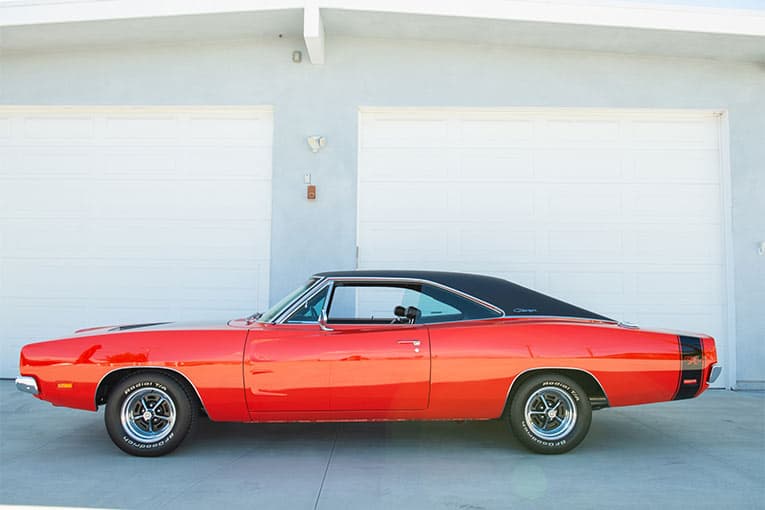The restyled, second-generation Dodge Charger arrived in 1968. Dodge designers and engineers were tasked to create and develop a performance coupe that looked ready to race on Daytona’s high banks, but still be driven on the streets.
The result was an exterior design with a “double diamond” or horizontal “Coke bottle” silhouette, a reference to the new design’s muscular bulges above the front- and rear-wheel wells. Further enhancing the sleek design was a “flying buttress” or swept-back tunneled roof lines around the rear glass. Sculptural twin scallops on the hood and doors created more dramatic surfaces than most slab-sided vehicles of the era. Other notable design features included a contrasting vinyl roof and flip-top gas cap. The all-new interior featured front bucket seats with an optional cushioned center console.
The new second-generation Dodge Charger was a sales success, with a 343 percent sales increase compared with the 1967 model. With this success also came fame, and in 1968 the Dodge Charger made its film debut in the movie “Bullitt” starring Steve McQueen. The movie featured a black Dodge Charger R/T with a black vinyl top and the powerful 440 Magnum V-8 engine with a four-speed transmission.

Keeping the second-generation Dodge Charger fresh, the 1969 model year featured several evolutionary styling changes, including a revised front grille with a center divider, which created two smaller symmetric rectangular grilles. Round turn signals and tail lamps were replaced with rectangular units.
the Special Edition (SE) package was available as an option to give the Dodge Charger more personality. This package included leather and vinyl seating options, wood grain trim, deep-dish wheel covers, hood-mounted turn indicators, and “Special Edition” badging on the C-pillars. This package was available on all models and would be the only year it would also be available on the base vehicle.
A late 1969 model year introduction was the Performance Hood option. Later model year Dodge Chargers featured performance hoods with functional hood scoops and air dams that allowed cool air to be drawn into the engine. The result was an improvement in performance and horsepower. These functional performance hoods featured manual controls often located on the instrument panel, allowing the driver to manually open and close the baffles as needed.

The 225 cubic-inch “Slant Six” became the standard engine. It delivered 145 horsepower. During the 1969 model year, fewer than 2 percent of all Dodge Chargers were produced with the 426 HEMI V8 engine, yet it contributed immensely to the lineup’s performance image.
Dodge Charger received another set of minor styling changes for 1970. The coupe now sported a full-width single opening grille, accented by a scripted “Charger” badge. Driver and passenger door scallops continued on all models, while the R/T model received rearward facing fiber glass scoops with a large “R/T” emblem. Additional customization options included a redesigned rear Bumble-Bee stripe that was changed to a single solid line design available in 18 accent colors.
New for the 1970 Dodge Charger base model was a split-back vinyl bench seat, while the Charger R/T and 500 models continued with sport bucket seats. Minor modifications were also made to interior door panels and included the “Charger” script badging. Only three Dodge Charger trim levels were offered in 1970; base, R/T and 500.










